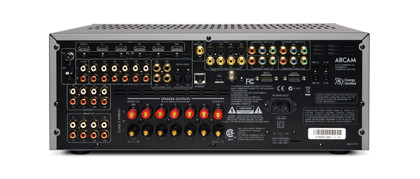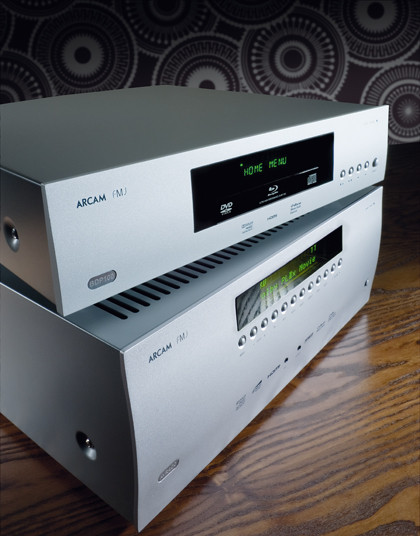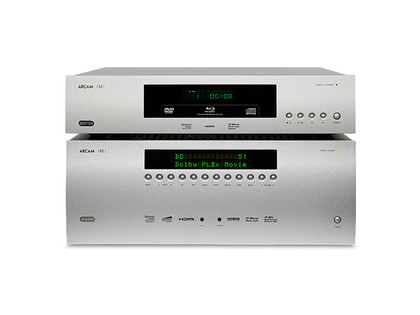TechRadar Verdict
Pros
- +
Fastidious build quality
- +
Distinctive analogue sound quality
- +
Fabulous dynamics
- +
Blu-ray and DVD picture quality
Cons
- -
AVR lacks a second HDMI output
- -
No THX-certification
- -
BD player has uneven media file support
Why you can trust TechRadar
It's clear when you unbox Arcam's new seven-channel AVR400 receiver that it shares DNA with the highly rated AVR600. A classic Class A-B design, it aesthetically follows the distinctive lines of its bigger brother.
That means no volume knob and a Shrek-green LED display window underscored by input and function buttons. There is no front-mounted video source input, although it does begrudgingly offer an analogue/digital 3.5mm audio input and allows headphones to be hooked up.
Our review sample came in a striking silver grey; it's also available in sombre black. Beneath the surface, you'll find other similarities with the AVR600.
It benefits from the same jitter reduction tech developed for its bigger brother, using identical D-to-A conversion chips, while the same attention has been paid to reducing digital noise within the chassis.
The AVR400 is not a super heavyweight. It tips the scales at 15.5kg and stands (a mere) 172mm tall. This leanness is reflected on the back panel, which (refreshingly) is not a wasteland of unwanted legacy connections. There's provision for the switching and control of seven analogue and six digital sources.
Given the price, I can't help feeling that the AVR400 could be a shade more accommodating. There's a solitary HDMI output. For some buyers this could be a deal breaker, should they need to feed both a flatscreen TV and a projector.
Once it is installed, a certain amount of setup is required. The OSD is an unfussy, text design which covers General Setup, Auto setup, Speaker Types/Distance/Levels, video inputs and outputs, Mode, Zone and Network. The AVR itself offers a considerable amount of picture processing control, as well as a range of display options.
Sign up for breaking news, reviews, opinion, top tech deals, and more.
For the best picture quality, the AVR400 should use Bypass and Follow Input output settings. This is because there appears to be a bug in the Faroudja Torino DSP used by the AVR400. Under lab conditions we identified a reoccurring frame skip on horizontal movement. By using the above settings, this cuts the Torino out of the loop.

Speaker calibration can be done manually via the onscreen menus, or automated using the supplied mic (if you're running anything other than a 5.1 or 7.1 system, the auto calibration won't work).
Spread the audio love
If you don't have a 7.1 speaker system you can bi-amp the front stereo pair, using the Surround Back speaker outputs. Alternatively, you could use them to top feed a stereo pair in another room.For this audition though, we ran the AVR400 in its 7.1 channel configuration.
There is network music streaming and internet radio, although getting to it is convoluted. With no dedicated remote button, you need to press Shift and then Net to call up the AVR's network interface. From here, you can listen to online radio sources, stream music across your network (the interface is pretty basic, so there's no album art support), or listen to music files from USB.
File support includes FLAC, MP3, WAV, AAC and WMA. In addition to DAB, there's an AM/FM receiver. The Ethernet LAN is the only way to get the receiver online. It doesn't have integrated Wi-Fi and won't work with a dongle.
You won't find any Audyssey post processing or THX modes onboard. The AVR400 plays it straight, with lossless Dolby TrueHD and DTS-HD Master Audio decoding for Blu-ray, plus DTS Neo 6 and Dolby Digital 5.1, Pro-Logic IIX and Surround EX processing for other sources.
Stereo processed via Pro-Logic's multichannel Music mode can be masticated via a variety of filters: Dimension can be used to bring the soundfield forward, while Centre Width broadens the front channel; Panorama extends the audio to the side speakers creating a wrap-around effect.
This is academic. With music, I found DTS Neo 6 trumped all Dolby PLIIx modes; offering better vocal delineation and a more convincing wrap-around spread – especially when applied on a digital input.
Choose your content carefully though. While exquisitely engineered MOR from Emi Fujita worked well, My Chemical Romance's Danger Days: The True Lives of The Fabulous Killjoys sent multichannel algorithms berserk.
The AVR400 was auditioned alongside Arcam's debut Blu-ray player, the BDP100.
To say that Arcam's move from DVD to Blu-ray has been traumatic is an understatement. Caught out by the sudden capitulation of HD DVD when it was developing a dual-format player, and then scuppered by chip suppliers, bringing a BD spinner to market has been an upward struggle.

But the wait is finally over. Somewhere along the way, the BDP100 has lost its multichannel analogue output, but given how good jitter reduction is on the AVR400, I don't think it's a significant loss. This player has clearly been designed to partner Arcam's AVRs from the outset. It's a perfect cosmetic match with similarly immaculate build quality.
Compared to BD decks loose in the mainstream it's a goliath. Some 400mm deep, and weighing 6.2kg, this is a very studious looking disc-spinner.
Connectivity is standard. As well as a single HDMI, the BDP100 offers component and stereo audio outputs, optical and coaxial digital audio, and Ethernet. It has a solitary USB slot, but throwing open the door to custom integrators, there's also a second zone stereo phono output, 12V trigger, remote IR sensor input and RS232 for system control.
Back to basics
Despite its girth, the BDP100 is a conventional player. It's not 3D compatible, and there's no online portal of IPTV content nor social media apps to explore. Neither will the player stream across a network.
It will however play a selection of sound and vision codecs from local USB. However, file support confounds. When fed our standard test folder of files, it choked on AVIs. One refused to play altogether, the other gave audio only – normally these files are bullet proof.
However, it was quite happy with HD MKV wrapped content and MP4. It could not play MOV or AVCHD. Music support covers MP3, WMA and AAC, but not FLAC, AIFF or OGG . While most BD players are plug and play, some care needs to be taken with the BDP100.
Once connected, I jumped straight to the menu and did what came naturally: selected 1080p as my output resolution, and when forced to select either NTSC or PAL I opted for the latter. This transpired to be a mistake. Blu-rays played with a horrible choppy motion. It seems that the player was forcing the 1080/60 signal to 1080/50, resulting in a really quite unwatchable lash-up.
This is one of the few BD player's I've come across which doesn't auto-detect PAL and NTSC. By telling the player that it was outputting to an NTSC screen, 60Hz playback returned to normal.
Another solution seemed to be to leave the player on PAL and tick the HDMI Auto Resolution output option.
With the BDP100 laced up to the AVR400, it quickly becomes apparent that the AVR400 has a full, rich character. My Reference buddy Emi Fujita sounded like she'd put on a few pounds since I last heard her, but it rather suited her.
Her lounge lizard reworking of All My Loving oozes one-for-the-road ambiance. There's believability to the AVR400's soundstage which is beguiling, and there's something distinctly analogue about the presentation. Fujita's backing band seems to step out from the shadows. Suddenly I was in a Tokyo Skyview bar, circa 1995.
It's also great fun with blockbusters, and there's no shortage of power in reserve. Our Tech Labs measured two-channel stereo output at 145W into 8Ω. This drops somewhat in 7.1, but not to a noticeable degree. We clocked 95W when driving seven channels at 8Ω.
This loss certainly wasn't an issue when listening to the DTS-HD MA mix of Prince of Persia or the jazzy DTS-HD MA melody of Chiele Minucci's Daybreak.
Arcam BDP100 testing data
Power consumption: 20W (playing); 15W (idling);
Fair figures from what is a high-end player
Audio jitter (analogue output): 7407.3ps (NOT Ps)
Considering that what we have here is a product from a respected hi-fi manufacturer, this result (from track 7 of the test CD) is appalling! We tried the same test with the outermost jitter track of the test CD - the result was even worse (9849.6ps). Yet Arcam claim 'audiophile-grade CD music playback'. Hmmm. Still, What Hi-Fi love the sound quality...
Video jitter (analogue output): 4ns (NOT Ns)
A fair result, but we've measured better. But no visible instability, from either composite or component outputs
Boot speed (press eject from standby): 17sec (from standby to full extension of tray and GUI appearance)
Loading speed (sliding in disc to appearance of 'Speed Kings SE' disc menu): 65sec
Noticeably slower than some considerably-cheaper hardware (such as the Panasonic BDT300 - which, unlike the Arcam, can also do 3D. Intriguingly, Arcam are rumoured to be working on a 3D firmware upgrade for the BDP100.).
Arcam AVR400 testing dataPower consumption (Watts):
Idling: 100W
A beefy amplifier that uses a lot of power even when idling
Powered: 140W
Real world consumption with movie playback averaged 140W
Power ratings (Watts (8Ω , 0.5% THD)):
Untainted: 125 Watts
A figure of 125W with 0.01% THD (two channels into 8Ω) falls a little short of some of its (admittedly
more expensive) high-end rivals
Signal/noise (dB):
20Hz: 90dB
1kHz: 90dB
20kHz: 90db
Good results across the frequency range
No hurry

Blu-ray Disc loading speeds on the BDP100 can aptly be described as leisurely. Lou Reed's Berlin (a very simple authoring job from Artificial Eye) went from tray loading to menu screen in 40 seconds; the remastered Goldfinger (from Fox Home Entertainment) served up the 007 logo in one minute 14 seconds – this compares to just 46 seconds on the Sony BDP-S570.
Video performance is terrific. Detail is high and colour fidelity excellent. Interestingly, the player's DVD performance is also stunningly good. All DVD content is upscaled to 1080p and the quality of the deinterlacing is superb. The player not only aced all the standard HQV jaggies tests, it took that darn American flag and rewove it out of cherry blossom.
The deck is also an accomplished CD spinner. Andy Moore, Arcam's senior engineer, tells me that he feels it sounds closer to the brand's high-end CD37 CD player than the more affordable CD17, and he may be right.
My advice is to run an analogue stereo output to the CD input of the AVR, and then play using the Direct function. This turns your system into a high-performance stereo pre-amp/power amp combo with a CD player.
If the BDP100 isn't to your liking, and you intend to partner the AVR400 with another deck, I can confirm its compatibility with a 3D Blu-ray source.
Ultimately, both the AVR400 and its Blu-ray BDP100 stablemate impress. I suspect that longstanding lovers of Arcam's distinctive sound design are going to be very pleased with it indeed.
I have some reservations about the Blu-ray player though. Having to wrestle with output options to simply get smooth playback really is an unnecessary inconvenience. I've given this duo a Best Buy badge overall, but it's the AVR400 that does more to earn that plaudit.
This pairing will not, of course, be to everyone's taste, and the hardware offering may be considered conservative compared to the competition – but this isn't about digital doodads, it's about musical performance.
Follow TechRadar Reviews on Twitter: http://twitter.com/techradarreview

Steve has been writing about AV and home cinema since the dawn of time, or more accurately, since the glory days of VHS and Betamax. He has strong opinions on the latest TV technology, Hi-Fi and Blu-ray/media players, and likes nothing better than to crank up his ludicrously powerful home theatre system to binge-watch TV shows.
